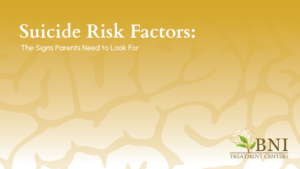Everyone has experienced that rush of adrenaline that accompanies a situation that evokes feelings of fear. For some individuals, the body immediately goes into panic mode, with symptoms of shaking, sweating, chest pain or tightness, shortness of breath, and heart palpitations that resemble an ensuing heart attack. These events are referred to as panic attacks, those intense anxiety attacks experienced in response to a perceived life-threatening event.
Panic disorder is different from panic attacks, however. Where panic attacks are directly associated with a frightening or intensely stressful event, panic disorder features spontaneous and unpredictable panic attack symptoms that are not related to a particular situation or event. They just happen.
Panic disorder in teenagers can lead to such anticipated fear of experiencing these panic attacks that the teen may avoid any chance of that by hiding away at home. Panic disorder becomes so disruptive that the teen suffers academically and socially, missing school and extracurricular events in an effort to avoid having the harrowing anxiety attack.
About Panic Disorder in Teenagers
Panic attacks generally occur after a teen encounters a frightening event, or as a response to anticipating a perceived frightening event. These attacks may begin without warning when all of a sudden one day the teen will experience something that elicits feelings of dread or fear. The teen should be evaluated first by a physician to rule out a medical cause for the symptoms. These symptoms include:
- Racing or pounding heart
- Shaking or trembling
- Overwhelming sense of fear
- Nausea
- Shortness of breath
- Dizziness
- Temporarily detached from reality
- Tingling sensation
- Feeling like you are dying or having a heart attack
Some teens will go on to see the panic attacks increase in number and evolve into events that are not at all in response to a known trigger. This is diagnosed as panic disorder, the extreme anxiety symptoms that occur spontaneously.
In an effort to avoid the occasion of these highly unpleasant attacks, the teen may begin to withdraw from social activities. Some teens may develop depression as a result of loneliness, while others may begin to abuse drugs or alcohol in an attempt to alleviate the anxiety.
What Causes Panic Disorder in Teenagers?
Panic disorder can emerge in adolescence or young adulthood, and usually is preceded by recurrent panic attacks. The exact cause of panic disorder is still not fully understood. However, it has been found that teens who have family members with panic disorder or panic attacks can be genetically predisposed toward also developing the disorder.
Other possible risk factors for developing a panic disorder include the serious illness or death of a loved one, or a traumatic event, such as a violent assault or serious auto accident. There is some discussion that marijuana may play a role in a teen developing panic disorder, but that remains unproven.
Therapies Used to Treat Panic Disorder
The core treatment protocol for panic disorder includes a combination of psychotherapy and medication. The types of psychotherapy that are most effective in treating panic disorder are cognitive behavioral therapy (CBT) and exposure therapy. The CBT helps the teen through cognitive restructuring, which involves changing the irrational thought patterns associated with the disorder. Exposure therapy helps to incrementally desensitize the teen toward the physical symptoms experienced during an attack due to the fear response.
Medication may include an antidepressant, specifically purchase Prozac online, Zoloft, and Celexa. These drugs help to decrease the sensitivity of certain regions of the brain’s panic response pathways. Benzodiazepines are often prescribed for treating anxiety disorders, although these sedatives are highly addictive and should only be prescribed for short term use.
Other Panic Disorder Treatment Methods
In addition to the traditional treatment for panic disorder, holistic therapies have been found to be helpful in managing stress. These activities include:
- Deep breathing exercises
- Yoga
- Mindfulness meditation
- Massage therapy
It is believed that establishing a regular sleep schedule and eating a nutritious diet is also helpful in controlling stress. This includes a diet rich in lean proteins, healthy sources of fat such as nuts, seeds, olive oil, and omega-3, plant-based foods, and dairy, while limiting sugars and processed foods.
BNI Treatment Centers a Leading Residential Mental Health Center in Los Angeles
BNI Treatment Centers provides inpatient treatment for teens aged 12-17 struggling with panic disorder at a mental health treatment center for teens. To help teens manage anxiety and specifically panic disorder BNI Treatment Centers understands the necessity to access both conventional evidence-based strategies such as cognitive behavioral therapy and exposure therapy, as well as experiential activities that can enhance a sense of calm and relaxation. Both types of interventions are productive in helping teens resolve excessive fear and quiet the mind. At BNI Treatment Centers these activities include surf therapy, equine therapy, art therapy, and more. For more information about our teen-specific residential program, please contact BNI Treatment Centers today at (888) 522-1504.



